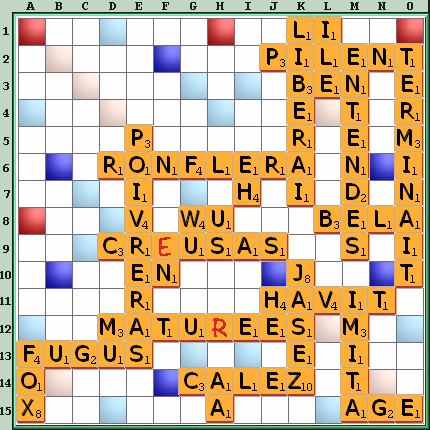Overview of possible next steps
Moves that will give you the best winning chances in the endgame against a human player
Many heuristics can be used to distinguish moves that would make the task of winning the game harder for a human opponent.
The idea would be to find moves that put the opponent in one or many of the following situations:
- There are few winning moves
- Winning sequences are long (6+ plies, say)
- Winning moves score much less than the highest scoring moves
- Winning moves do not block a huge play for the opponent
- Winning moves keep a bad leave
- Winning moves are hard to find, either because:
- They make use of no coloured square
- They involve long words (9+ letters)
- They involve words with atypical sequences of letters
- They make use of a blank as the first letter of the word played
- They make use of a blank as a heavy letter
- They involve hooking on multiple (possibly non-adjacent) letters already on the board
- They involve playing on both sides of a (3+)-letter word already on the board
- Et cætera
Example in French with the ODS8 dictionary
It is player A's turn and he is trailing by 84 points.
Player A's rack: DDKOSUY
Player B's rack: AEEOOOQ

In this example, player A has no winning move. However, one move stands out as giving him the best chances of stealing the game against a human: [DE 4J 3 DKOSUY], with the idea of playing [DO I3 9 KSUY] and [KYUS H1 78] next. This move stands out because:
- Player B must play [AÈDE 4H 6 EOOOQ] to win the game
- If player B plays [AÈDE 4H 6 EOOOQ] then he keeps a bad leave
- If player B plays [AÈDE 4H 6 EOOOQ] then he lets player A play the lucrative [KYUS B11 48 DDOU]
Indeed, the setup that player A wants to execute after [DE 4J 3 DKOSUY] is subtle and player B might be tempted to block [KYUS B11 48 DDOU] anyway by playing [OU B12 2 AEEOOQ], getting rid of an O and thinking that player A would be stuck with one of his two heavy letters
- The winning sequences are relatively long and precise calculations are required
Pre-endgame solver
Pre-endgames are situations where there are a few tiles left in the bag, say between one and four. Our endgame solver could be used to solve such problems.
We could have a mode that finds the moves that win all the time and more precise modes that would give statistics about each move, such as:
- Winning percentage, with details about each eventuality
- Worst possible scenario, e.g. it might be crucial to know that, given optimal play by both sides, a move will let you gain at least X points over your opponent
- Expected value and variance of the spread differentials
- Et cætera
Without too much additional efforts, we are already able to work out pre-endgame winning, losing and drawing percentages when exactly one tile is left in the bag. Here are some examples, taken from Nigel Richards games, where we give results in a minimal fashion.
English Dictionaries
- Collins Scrabble Words, 2019
CSW19 ➔ 4 games
- Official Tournament and Club Word List, 2016
OTCWL16 ➔ 2 games
- Collins Scrabble Words, 2015
CSW15 ➔ 6 games
- Collins Scrabble Words, 2012
CSW12 ➔ 1 game
- Collins Scrabble Words, 2007
CSW07 ➔ 6 games
- Tournament Word List, 2006
TWL06 ➔ 7 games
French Dictionaries
- Officiel du scrabble, 7e édition (2016-19)
ODS7 ➔ 3 games
- Officiel du scrabble, 6e édition (2012-15)
ODS6 ➔ 1 game
Opening and middle game analysis
When too many tiles are left in the bag, precise solutions are unreachable. However, heuristics and simulations can be used to get a good idea of what the best moves are. Here are some examples of information we could try to provide:
- Which moves block the most bingos for the opponent?
- Which moves open the board the most, in the sense that the number of playable moves with the letters not already on the board is maximal?
- Illustrating with a heat map, if it was the opponent’s turn, on which square would he likely score the most?
- Which moves offer the “best” leaves based on the remaining letters and the current board position?
- What kind of rack might the opponent have based on his last play(s), assuming that he plays sensible moves?
- Based on the unseen letters and the current board position, what is the probability that the opponent has a play of at least X points?
- Based on a given rack and board position, and assuming you can play as many moves as you want in a row, what are the most lucrative setups?
- Et cætera
Automatically generated endgame problems to practice
As far as we know, the game of scrabble is well behind the game of chess in terms of in-game exercises. Indeed, most chess sites offer puzzles, and some even specialize in that, e.g. chesstempo that offers thousands of them and categorizes them. What our community does have, though, are tools to train with anagrams and practice in the duplicate format.
We have the tools to automatically generate endgames, solve them and categorize them. Therefore, we could offer exercises in a website for players to dynamically practice endgames.
Software to play against the computer and analyze games
Everything described above could be part of a software that would allow you to train, play against the computer and analyze your games. We would make sure that players of all levels would gain something playing against the top engine.
Return to home page
